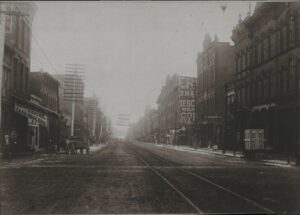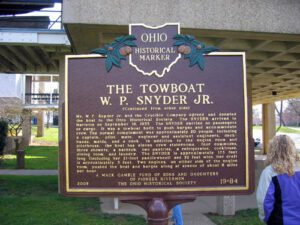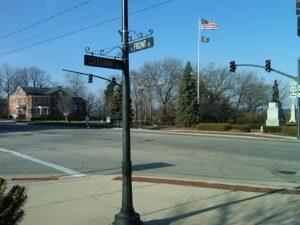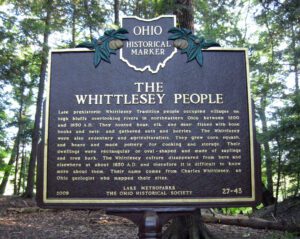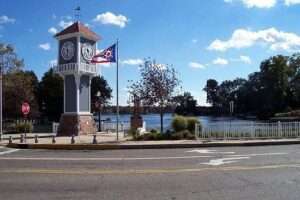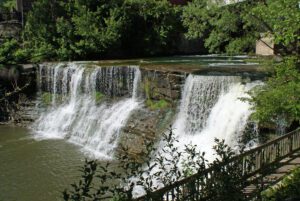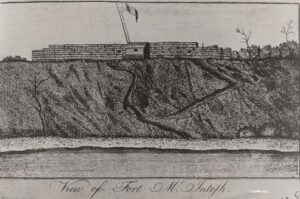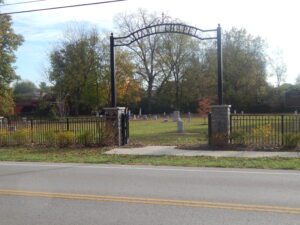, OH
The center of African-American culture in Akron during the mid-20th century, Howard Street was home to many of the city’s black-owned business and entertainment establishments, and provided an atmosphere in which minority-owned businesses could thrive. Attracted to the vitality of the neighborhood, entrepreneur George Mathews (1887-1982) established a barbershop here in 1920 and in 1925 opened the adjoining Mathews Hotel. The hotel quickly became the anchor of the Howard Street district. Mathews’ success allowed him to endow a scholarship fund at the University of Akron in 1964.
, OH
The W.P. SNYDER Jr. is one of the few links between the age of steam-powered, stern-wheeled towboats and the diesel-powered, propeller-driven vessels that push barges on America’s rivers today. The James Rees and Sons Company in Pittsburgh built the boat for the Carnegie Steel Company, and she was launched in 1918 as the W.H. CLINGERMAN. During the boat’s working life, she primarily pushed barges loaded with coal on the Monongahela and Ohio Rivers. After various changes in name, the Crucible Steel Company of America bought the boat in 1945 and named her the W.P. SNYDER Jr. after the company’s president. Crucible retired the SNYDER in 1954 and, as was the fate of her kind, she would have probably been scrapped. In 1955, however, the Sons and Daughters of Pioneer Rivermen and the Ohio Historical Society concluded that one example of a steam towboat should be preserved. (continued on the other side)
, OH
Following the War of 1812, settlers reestablished the 1810 Maumee River town, Port Miami of Lake Erie, on the land below the deserted Fort Meigs. The inhabitants nicknamed the new town “Orleans of the North” in honor of New Orleans in the Louisiana Territory. Orleans was destroyed twice by the river’s spring ice floes. Consequently, on April 27, 1816, at the suggestion of the town’s founder Amos Spafford, the United States Congress agreed and a new town was platted to the east and up on the bluff. Spafford named the town Perrysburg, formerly spelled Perrysburgh, in honor of Commodore Oliver Hazard Perry’s 1813 victory over the British fleet in Lake Erie. Wood County was founded in 1820 and included Maumee, which separated when Lucas County was formed in 1835. Perrysburg was the county seat from 1823 until 1870 when the county government was moved to Bowling Green.
, OH
The Indian Point Site contains the remains of a prehistoric Native American earthen enclosure, officially known as the Lyman site, named after a former property owner. The site contains two earthen walls that are bordered by ditches. Steep cliffs provide natural barriers on two sides of the enclosure. Archaeological digs have uncovered many artifacts here, including pottery sherds, tools, pipes, and beads. There is evidence that the walls were built around 140 B.C., and the site was occupied again around 1500 A.D. by the Whittlesey Tradition people. It is uncertain if the site was a village or was used as a ceremonial center. After 1650 A.D., the area became a neutral hunting ground for various historic tribes.
, OH
The land on which Coventry Township is situated was ceded in 1785 to the United States by the Delaware, Chippewa, Ottawa, and Wyandot tribes under the Treaty of Fort McIntosh. The area was a choice location for Native Americans, settlers, and fur traders due to the abundant bodies of water and proximity to the Portage Path, a land connection between the Tuscarawas and Cuyahoga rivers and Lake Erie. In 1788, Coventry Township was initially part of Washington County, the first county formed in the Ohio Territory. After Moses Warren finished a survey in 1797, a succession of county splits located Coventry Township in Jefferson County, Trumbull County, Portage County, and, finally, Summit County in 1840. The township originally encompassed Summit Lake and the lands south to the southern line of the Western Reserve (Green-New Franklin lines). Daniel Haines was the first resident to settle in Coventry Township in 1806.
, OH
The Chagrin River was named for Francois Seguin, a Frenchman who traded with Native Americans in Northeast Ohio circa 1742. The “High Falls” of the Chagrin River primarily attracted settlers from New England (circa 1833) seeking a location with ample waterpower. By the mid-nineteenth century an axe factory, a foundry, 2 flour mills, 4 woolen mills, 2 sawmills, 3 paper mills, and a woodenware factory had been built along the riverbanks in Chagrin Falls. The “High Falls” provided a power source for a gristmill, built in 1836 at this location. Today, only one factory remains in operation in the Village of Chagrin Falls.
, OH
In 1785, American Indian tribal leaders from the Chippewa, Delaware, Ottawa, and Wyandot met with representatives sent by the United States Congress to sign the controversial Treaty of Fort McIntosh. The treaty surrendered control of Native American lands in southern and eastern Ohio to the United States government. Most Indians rejected the validity of the treaty and rather than improving relations, the Treaty of Fort McIntosh only intensified the tensions that existed between the United States government and the Indian tribes. This marker signifies the eastern most portion of the American Indian territory outlined by the treaty. The Portage Path, a trail used by American Indians as a portage between the Cuyahoga and Tuscarawas rivers, became a part of this boundary line.
, OH
Around 1843, local Methodists organized a new Methodist Episcopal church at Fair Play and later erected a brick chapel. The congregation was short-lived, however, and fell into decline after one of its leading members, Joseph Lashorn, moved to Hamilton. In 1876, Reverend F. G. Grigsby of the United Brethren church organized a congregation here, repairing and occupying the old Methodist chapel for the next several years. The cemetery is the burial place for veterans from the Revolutionary War, War of 1812, and Civil War; some of whom are interred in unmarked graves. The last known burial was Etta Thomas in 1941.


